THEME 1. MASTHEADS
|
| |
 |
Image 1A. Front Page Masthead (Irish World, January 13, 1872)
The Irish World's masthead embodies the notion of dual loyalty to both home and host by featuring a rural idyllic on the left (Ireland) and a bustling, industrious, new home (the United States) on the right.
|
|
|
|
| |
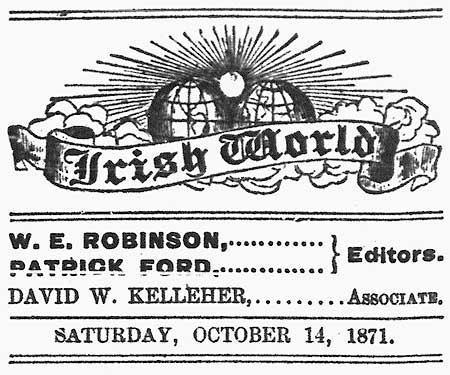 |
Image 1B. Editorial Board (Irish World, October 14, 1871)
Patrick Ford, owner and editor of the Irish World, had immigrated to the United States as a child during the Great Famine and worked as a printer's devil for William Lloyd Garrison's Liberator in Boston.
|
|
|
|
| |
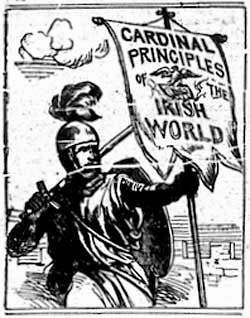 |
Image 1C. "Cardinal Principles of the Irish World" (Irish World, July 11, 1874)
Ethnic newspapers such as the Irish World often employed quasi-historical imagery from the Middle Ages in part to hearken back to what they perceived as a golden age in Irish history. |
|
|
|
| |
 |
Image 1D. "American Industrial Liberator" added to Masthead (Irish World, December 21, 1878)
See below for examples of cartoons elucidating the Irish World's sympathy for the working classes. |
|
|
|
THEME 2. NATIVISM AND THE AMERICAN DOMESTIC PRESS
|
| |
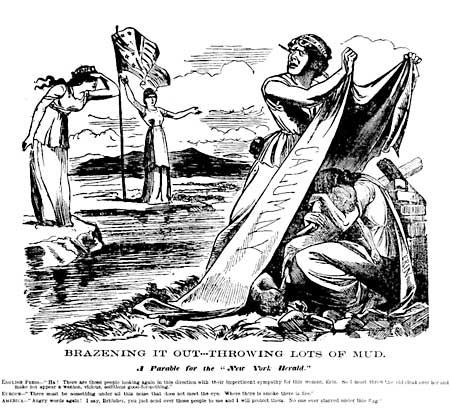 |
Image 2A. "Brazening It Out—Throwing Lots of Mud" (Irish-American, January
17, 1880)
The English popular press publishes calumnious lies in order to hide the truth about Ireland's plight from prying eyes in America.
|
|
|
|
| |
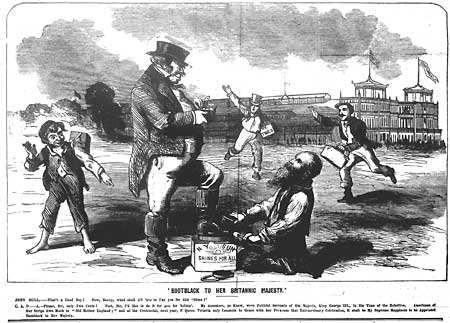 |
Image 2B. "Bootblack to Her Britannic Majesty" (Irish World, July 31, 1875)
New York dailies such as the Times and Sun rush to ingratiate themselves to a smug John Bull.
|
|
|
|
| |
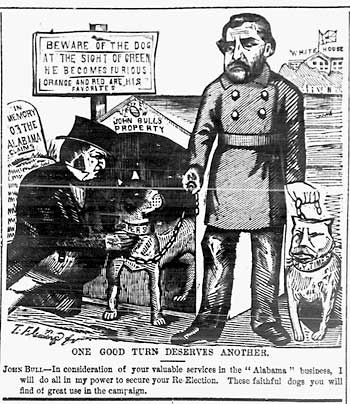 |
Image 2C. "One Good Turn Deserves Another" (Irish World, August 17, 1872)
John Bull rewards Ulysses Grant for his alleged acquiescence during the "Alabama Claims" dispute by giving him two dogs named "Harper's" and "N.Y. Times" to help him with his re-election campaign. |
|
|
|
| |
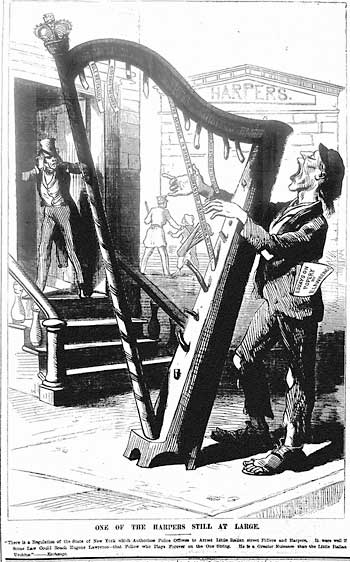 |
Image 2D. "One of the Harpers Still at Large" (Irish World, November 20, 1875)
Harper's Weekly is portrayed as an obnoxious street performer playing pro-British tunes on a broken harp. In the background, Uncle Sam is deeply annoyed.
|
|
|
|
| |
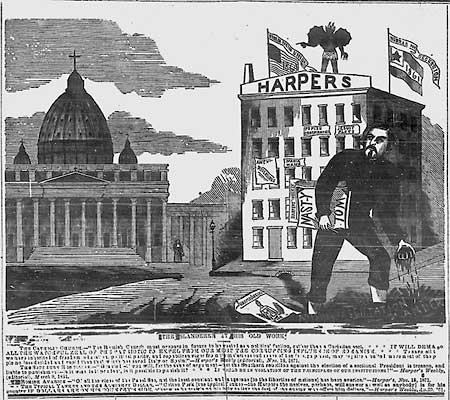 |
Image 2E. "The Slanderer At His Old Work" (Irish World, March 16, 1872)
Harper's Weekly cartoonist Thomas Nast flings mud at the Catholic Church from a puddle of slander and sensation.
|
|
|
|
| |
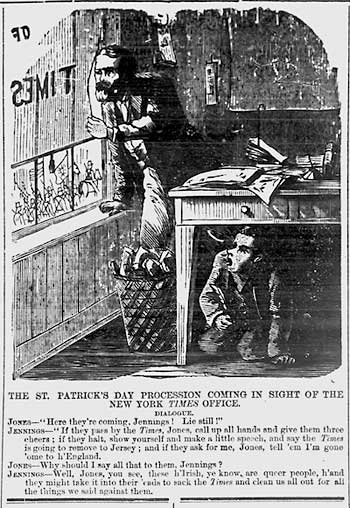 |
Image 2F. "The St. Patrick's Day Procession Coming in Sight of the New York
Times Office" (Irish World, April 5, 1873)
The editors of the New York Times regret having slandered the Irish Catholic population when the St. Patrick's Day parade passes nearby.
|
|
|
|
| |
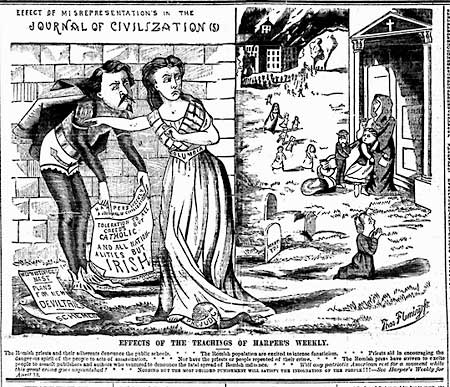 |
Image 2G. "Effects of the Teachings of Harper's Weekly" (Irish World, April 13,
1872)
Columbia rebukes Thomas Nast's anti-Catholicism, which has contributed to rioting and the burning of an orphanage.
|
|
|
|
| |
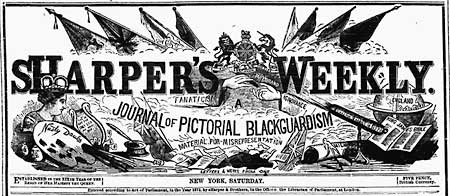 |
Image 2H. "sHarper's Weekly" (Irish World, July 12, 1873)
A mock masthead of Harper's Weekly portraying it as a "Journal of Pictorial Blackguardism."
|
|
|
|
THEME 3. IRISH CATHOLIC-PROTESTANT ANTAGONISM IN NORTH AMERICA
|
| |
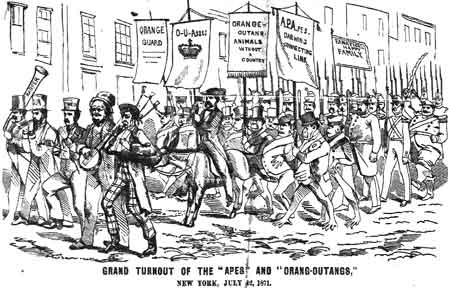 |
Image 3A. "Grand Turnout of the 'Apes' and 'Orang-outangs'" (Irish World, August 12, 1871)
Irish Protestant Orange Order marchers and American nativists are depicted using the simian imagery so often deployed against Irish Catholics.
|
|
|
|
| |
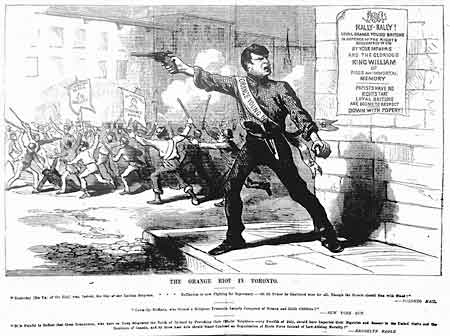 |
Image 3B. "The Orange Riot in Toronto" (Irish World, October 16, 1875)
Protestant-Catholic street riots, which had been a part of life in Ireland for over a century, were being imported to the new world.
|
|
|
|
| |
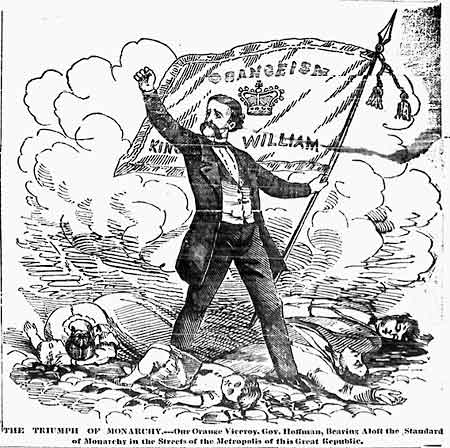 |
Image 3C. "The Triumph of Monarchy" (Irish World, May 27, 1871)
The Irish World alleges that John T. Hoffman, Democratic Governor of the New York, was actually a monarchist in disguise and the sworn abettor of anti-Catholicism in America.
|
|
|
|
THEME 4. IRISH CATHOLIC LOYALTY TO THE UNITED STATES
|
| |
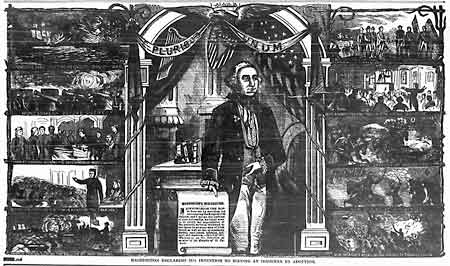 |
Image 4A. "Washington Declaring His Intention to Become an Irishman By
Adoption" (Irish World, March 29, 1873)
One of several cartoons that sought to show that the Revolutionary Fathers considered the Irish as loyal to the American Republic as any other ethnic group.
|
|
|
|
| |
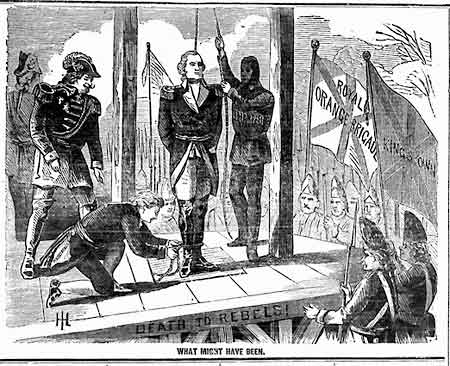 |
Image 4B. "What Might Have Been" (Irish World, February 22, 1873)
An attempt to suggest that Irish nationalists and George Washington both shared the same enemy: British monarchism.
|
|
|
|
| |
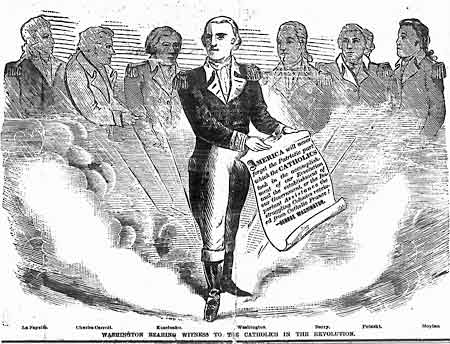 |
Image 4C. "Washington Bearing Witness to the Catholics in the Revolution" (Irish
World, March 2, 1872)
In the face of persistent claims by American Protestants that Catholics were unfit for American democracy, Washington is quoted as testifying to the crucial role they played in the War of Independence.
|
|
|
|
| |
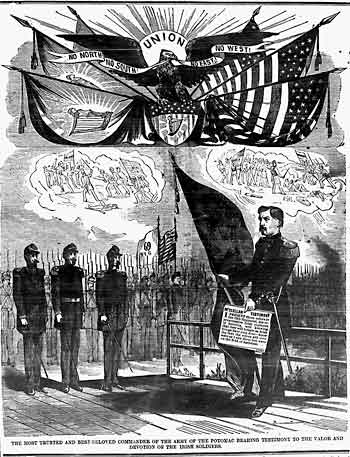 |
Image 4D. "[George B. McClellan] Bearing Testimony To The Valor and Devotion
of the Irish Soldiers" (Irish World, July 19, 1873)
Irish Catholic immigrants proved their loyalty to the American republic through military service in the Civil War.
|
|
|
|
| |
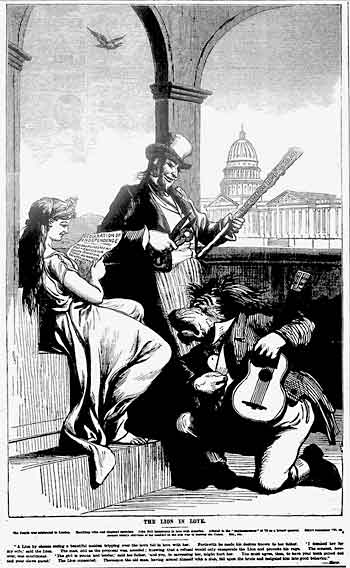 |
Image 4E. "The Lion In Love" (Irish World, July 14, 1877)
Great Britain seeks to ingratiate himself to Columbia. In the background, a quietly confident Uncle Sam watches with a heavy club of the "Irish-American Element—16,000,000" at the ready. |
|
|
|
THEME 5. IRISH AMERICAN IDENTITY
|
| |
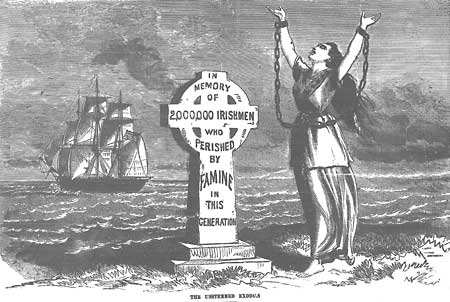 |
Image 5A. "The Unstemmed Exodus" (Irish World, March 10, 1877)
Ireland is a damsel in distress lamenting the dual afflictions of mass migration and mortality that have affected Ireland since the Great Famine (1845-1852).
|
|
|
|
| |
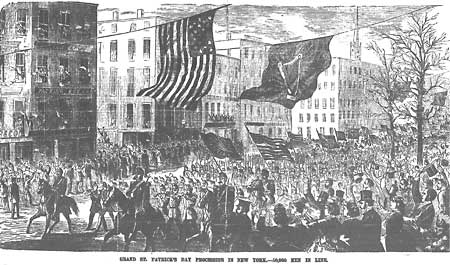 |
Image 5B. "Grand St. Patrick's Day Procession in New York—50,000 Men in Line" (Irish World, March 23, 1872)
Irish Catholic immigrants in the United States are fully capable of contributing to participatory democracy.
|
|
|
|
| |
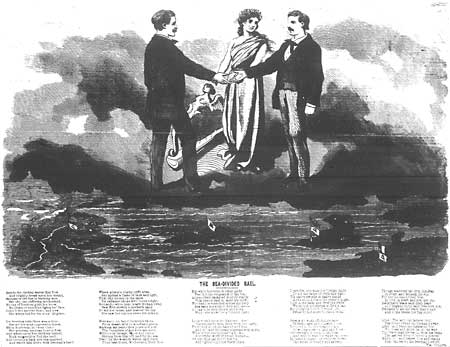 |
Image 5C. "The Sea-Divided Gael" (Irish World, September 12, 1874)
Irish people around the world are united by bonds of friendship and trust that no distance can erase.
|
|
|
|
| |
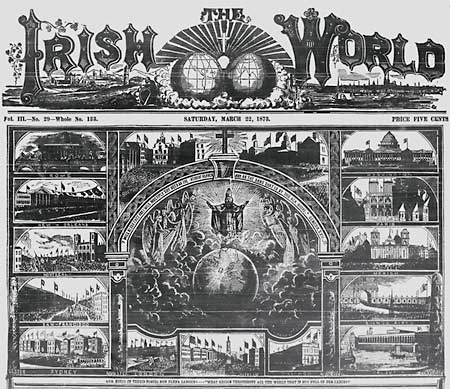 |
Image 5D. "What Region Throughout All the World that is not Full of our Labors?" (Irish World, March 22, 1873)
The worldwide celebration of Saint Patrick's Day was an annual opportunity to remind the Irish community of its international breadth.
|
|
|
|
| |
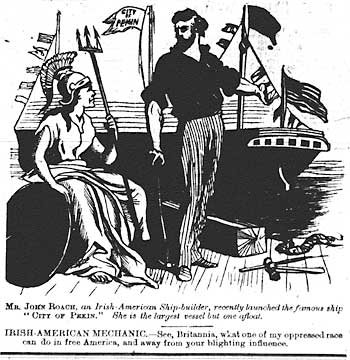 |
Image 5E. "Irish-American Mechanic" (Irish World, April 25, 1874)
Migration facilitates the full development of Irish abilities by freeing the people from British oppression.
|
|
|
|
| |
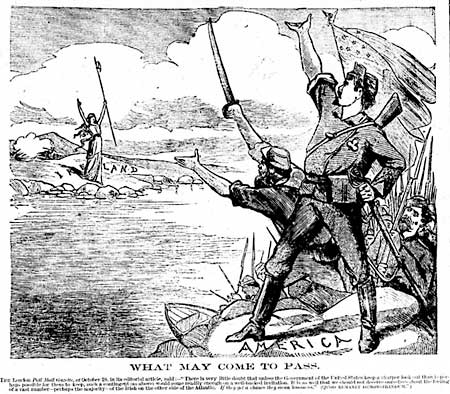 |
Image 5F. "What May Come to Pass" (Irish-American, November 27, 1880)
Irish American men, dually loyal to both the United States and Ireland, prepare to use what they have learned in America to liberate their homeland.
|
|
|
|
THEME 6. POLITICS IN IRELAND
|
| |
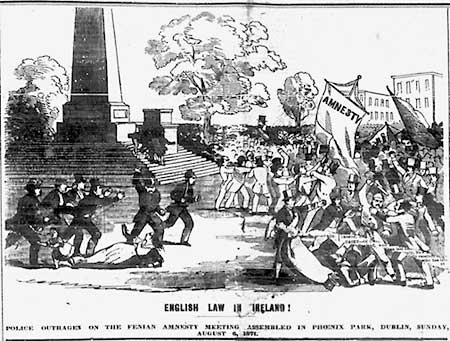 |
Image 6A. "English Law in Ireland" (Irish World, August 19, 1871)
Not all cartoons were explicitly concerned with affairs in the United States. Some, such as "English Law in Ireland," sought to draw the American population's attention to the political struggle in Ireland itself. |
|
|
|
| |
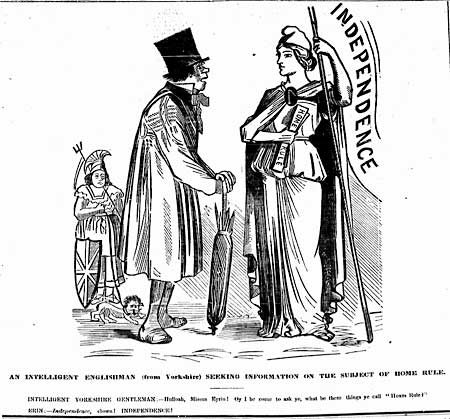 |
Image 6B. "An Intelligent Englishman" (Irish World, January 27, 1872)
Erin derides an Englishman who does not understand what the Irish home rule movement is trying to achieve.
|
|
|
|
| |
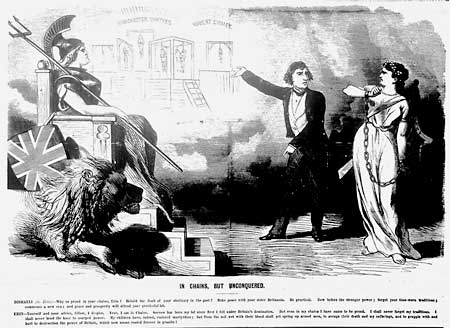 |
Image 6C. "In Chains, But Unconquered" (Irish World, April 24, 1875)
Benjamin Disraeli, the Conservative Prime Minister of Great Britain, unsuccessfully urges Erin to surrender her pride and submit to Britannia.
|
|
|
|
| |
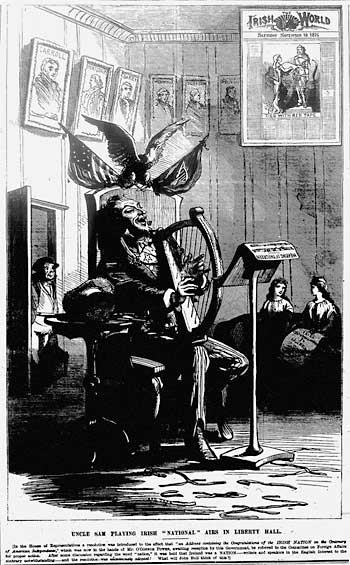 |
Image 6D. "Uncle Sam Playing Irish 'National' Airs in Liberty Hall" (Irish World, January 6, 1877)
Uncle Sam recognizes Ireland's right to nationhood while a disheartened John Bull looks on.
|
|
|
|
THEME 7. BRITISH EMPIRE
|
| |
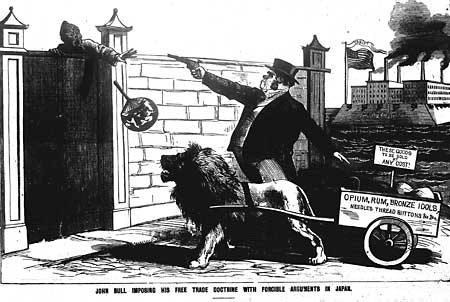 |
Image 7A. "John Bull Imposing His Free Trade Doctrine With Forcible Arguments in Japan" (Irish World, September 11, 1875)
The British imperial trade system, despite its claims of free trade, is actually based on violence and immorality.
|
|
|
|
| |
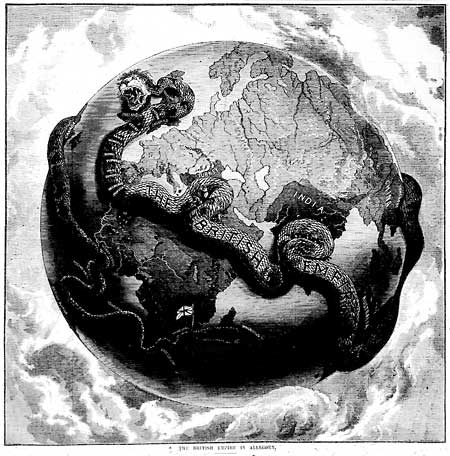 |
Image 7B. "The British Empire in Allegory" (Irish World, October 19, 1878)
The British Empire is an inhuman malefactor that knows no boundaries.
|
|
|
|
| |
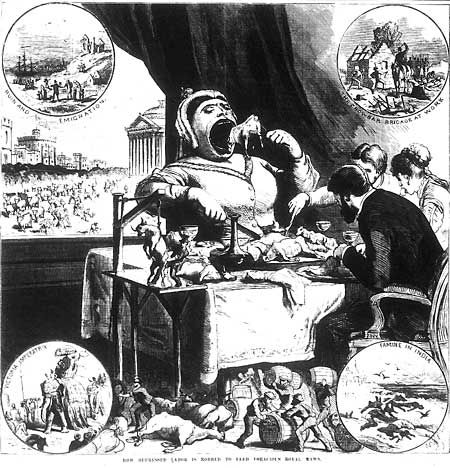 |
Image 7C. "How Oppressed Labor Is Robbed to Feed Voracious Royal Maws" (Irish World, March 17, 1877)
Queen Victoria and her family stuff their faces with food and drink while her subjects in Ireland and India starve to death.
|
|
|
|
| |
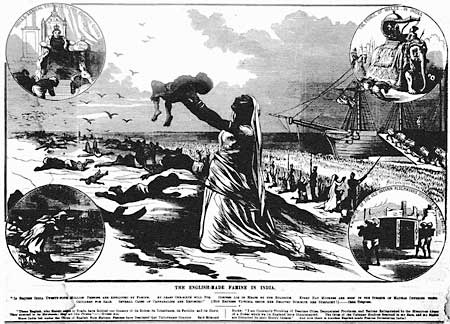 |
Image 7D. "The English-Made Famine In India" (Irish World, September 22, 1877)
The "Great Drought" in India was the result of British policies, which favored the imperial metropole even at the expense of Indian lives. |
|
|
|
| |
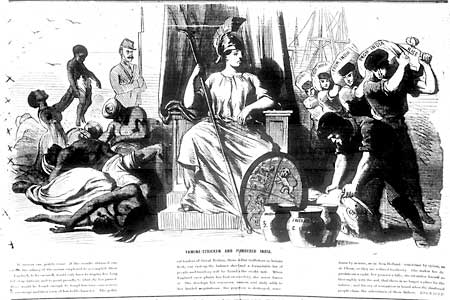 |
Image 7E. "Famine-Stricken and Plundered India" (Irish World, March 7, 1874)
Food and riches are steadily shipped out of India while its people starve to death under armed guard.
|
|
|
|
| |
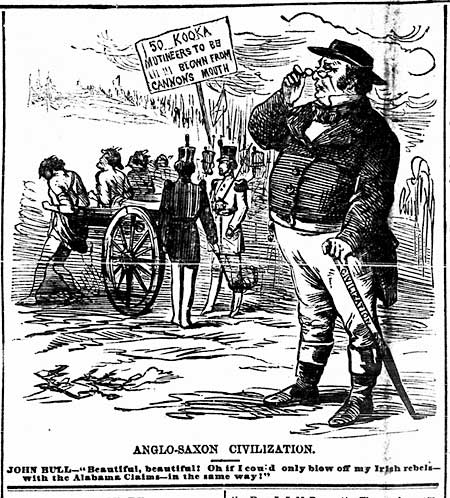 |
Image 7F. "Anglo-Saxon Civilization" (Irish World, April 6, 1872)
Despite his pretense of civility, John Bull orders that Indian mutineers be executed at the mouths of cannons.
|
|
|
|
THEME 8. LABOR AND AMERICAN INDIANS
|
| |
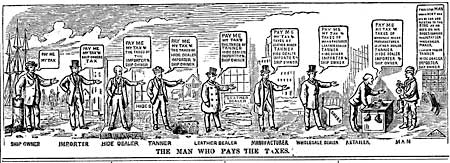 |
Image 8A. "The Man Who Pays The Taxes" (Irish World, October 12, 1872)
It is the average working man who bears the heaviest tax burden in American society.
|
|
|
|
| |
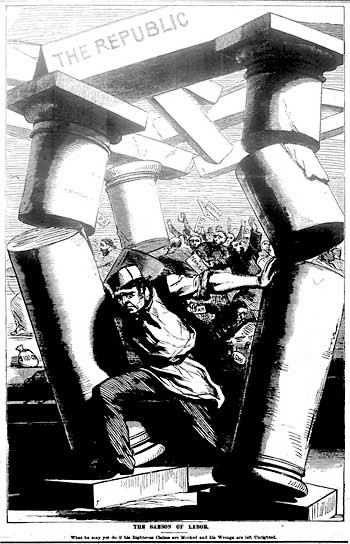 |
Image 8B. "The Samson of Labor" (Irish World, August 11, 1877)
Working-class strikers may yet bring down the American republic if their wrongs are not righted.
|
|
|
|
| |
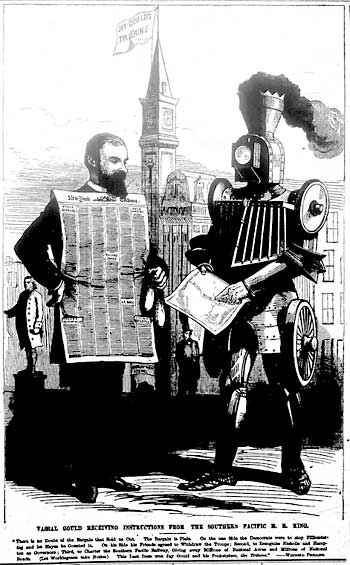 |
Image 8C. "Vassal Gould Receiving Instructions From The Southern Pacific R.R. King" (Irish World, April 28, 1877)
The Compromise of 1877 involved the government giving millions of acres to railroad companies like the Southern Pacific, thus benefitting speculators like Jay Gould.
|
|
|
|
| |
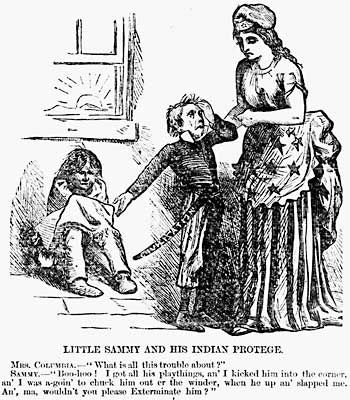 |
Image 8D. "Little Sammy And His Indian Protégé" (Irish World, May 3, 1873)
Uncle Sam is portrayed as a privileged little brat who received his fair due after mistreating his Native American Indian playmate.
|
|
|
|
| |
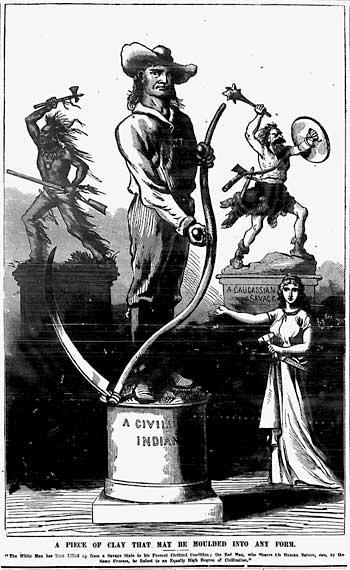 |
Image 8E. "A Piece of Clay That May Be Moulded Into Any Form" (Irish World, August 19, 1876)
Native American Indians were as capable of civilization and attainment as any other members of the human race.
|
|
|
|
|

